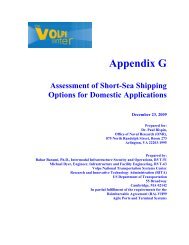Container-on-Barge Pre-Feasibility Study Final Report - Towmasters ...
Container-on-Barge Pre-Feasibility Study Final Report - Towmasters ...
Container-on-Barge Pre-Feasibility Study Final Report - Towmasters ...
Create successful ePaper yourself
Turn your PDF publications into a flip-book with our unique Google optimized e-Paper software.
Inventory Cost<br />
If barging adds to the delivery time, this needs to be calculated for the shipper. While each<br />
shipper or commodity may have its own way of calculating this cost, a rule of thumb can be used<br />
that it takes the value of goods times 1-2% per m<strong>on</strong>th to carry the extra time. Of course if the<br />
goods are perishable or very valuable, then they may not be suitable for barging at all.<br />
Even this, however, can be turned to the advantage of barging in certain circumstances.<br />
Intermodal Logistics Group’s John Pears<strong>on</strong>, who has been actively marketing COB to Mexico,<br />
has found that many shippers resp<strong>on</strong>d favorably to the “warehousing-in-transit” c<strong>on</strong>cept. In fact,<br />
some cargoes have such low value, such as wastepaper, that they cannot afford the cost of storing<br />
them in warehouses.<br />
Volume<br />
Finding a single shipper with sufficient volume and c<strong>on</strong>trol would be the easiest way for a carrier<br />
to enter the COB market. In fact, several attempts in the 1970s and 1980s were able to succeed<br />
for some time <strong>on</strong> this basis. However, the carrier <strong>on</strong>ly supplied enough equipment for that<br />
shipper and when the market c<strong>on</strong>diti<strong>on</strong>s changed, or if the railroads undercut them, then the<br />
business disappeared.<br />
Finding a few large shippers would be more a desirable strategy. However, in either case, the<br />
carrier should probably price a breakeven point at about 2/3rds of the captive cargo and market<br />
the excess capacity to other shippers.<br />
Next Steps<br />
The industry needs to dem<strong>on</strong>strate the potential for such an operati<strong>on</strong> to solve the “chicken and<br />
egg syndrome.” The next secti<strong>on</strong> details how the PPC analyzed the potential market coming out<br />
of Mexico for an LBL or COB service, and sets a model as to how other inland U.S. ports could<br />
analyze their own markets.
















